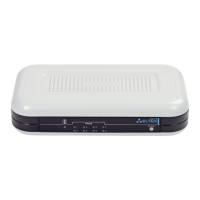71 VoIP Subscriber Gateways
Symbol '#' usage in dialplan can block end of dial by this key!
- Digit sequence enclosed in square brackets corresponds to any of the characters
enclosed in brackets.
Example: ([1239]) - corresponds to any of these digits: 1, 2, 3 and 9.
- Symbol range may be set through the dash. Most often used inside square brackets.
Example 1: (1-5) - any digit from 1 to 5.
Example 2: ([1-39]) - example from previous paragraph with other record format.
- Symbol 'X' corresponds to any digit from 0 to 9.
Example: (1XX) - any three-digit number, starting at 1.
- '.' - Previous symbol repeating from 0 to infinity.
- '+' - Previous symbol repeating from 1 to infinity.
- {a,b} - Previous symbol repeating from 'a' to 'b' times;
- {a,} - Previous symbol repeating less than 'a' times;
- {,b} - Previous symbol repeating less than 'b' times.
Example: (810X.) - international number with any digits amount.
Settings that affect dialplan processing:
- Interdigit Long Timer – entry timeout for the next digit, if there are no templates that
correspond to the dialed combination;
- Interdigit Short Timer – entry timeout for the next digit. If the dialed combination fully
corresponds to at least one template and if there is at least one template that requires
an extension dialing for the full matching.
Additional features:
1. Dialed sequence replacement
Syntax: <arg1:arg2>
This ability allows replacing the dialed sequence with any dialed symbols sequence. In doing
so, the second argument should be set as a defined value, both arguments can be empty.
Example1: (<83812:> XXXXXX) - this record will comply with dialed digits 83812, but
this sequence will be omitted and will not be transmitted to SIP server.

